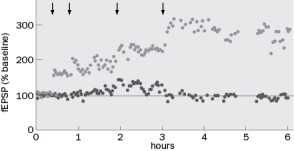Figure Q10-7 shows data from one of the first experiments demonstrating LTP by Bliss and Lomo (1973). The arrows indicate points at which high frequency stimuli were given.  Figure
Figure
A. Figure Q10-7A below depicts an example of a field EPSP prior to high frequency stimulation. The vertical line is the stimulus artifact. What would the fEPSP look like at 1 hour and 4 hours?  Figure Q10-7A
Figure Q10-7A
B. What would happen to the response if Bliss and Lomo had given a low frequency stimulation of about 1 Hz at 5 hours?
Question 10-8 and 10-9 refer to (Figure Q10-8) below. Figure Q10-8 shows a synaptic matrix, which describes how changes in synaptic weight can contribute to memory storage. There are presynaptic inputs A-E and postsynaptic outputs I-IV.  Figure
Figure
Definitions:
Standard Deviation
Standard deviation quantifies the variation or spread of a set of numbers from its mean, highlighting the volatility or risk associated with a financial instrument or investment.
Risk-Free Asset
An investment guaranteed to return the original investment without any loss, typically associated with high-grade government securities.
Indifference Curve
In economics, a curve that represents different combinations of goods or services among which a consumer is indifferent, showing preferences.
Risk-Free Asset
An investment that is expected to deliver its returns without any risk of financial loss, traditionally government bonds are considered close to risk-free.
Q1: There are five risk-neutral bidders, each having
Q1: Various concentrations of Shh along the dorsoventral
Q2: When people get older the lens becomes
Q9: Pink1 and Parkin mutant flies both die
Q11: Mammalian gustatory systems have evolved to avoid
Q18: What are 'silent synapses'? Select all that
Q32: Figure Q10-21 demonstrates spike-timing dependent activity. <img
Q39: What are <b>two</b> pathological features of patients
Q75: Three commonly used productivity variables are<br>A)quality,external elements,and
Q112: _ involves delaying any modifications or customization